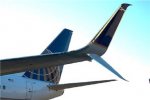You are using an out of date browser. It may not display this or other websites correctly.
You should upgrade or use an alternative browser.
You should upgrade or use an alternative browser.
United Boeing 737-800 with the new Spli
- Thread starter scandtours
- Start date
GyrOZprey
Aussie in Kansas.
- Joined
- Aug 8, 2011
- Messages
- 3,402
- Location
- Whitewater KS
- Aircraft
- Butterfly Aurora N5560Z / Titanium Explorer N456TE & N488TE/ - trained in MTOsport 446QT/488FB
- Total Flight Time
- 1023
Wow!
Wow!
That looks so amazing! ..... i'd like to see the pattern of air currents in a windtunnel ... (coloured air?) depiction of how they work!!!
Wow!
That looks so amazing! ..... i'd like to see the pattern of air currents in a windtunnel ... (coloured air?) depiction of how they work!!!
Fly Army
Member
- Joined
- Sep 7, 2007
- Messages
- 1,956
- Location
- Utah/summer Florida/winter
- Aircraft
- From un-powered Paragliders off the side of a mountain to the Boeing 777.
- Total Flight Time
- 18,000 ish , I guess
Yep, instead of buying a refinery we instead decided to concentrate on airplanes that save gas.
Chopper Reid
Senior Member
- Joined
- Jun 25, 2004
- Messages
- 1,326
- Location
- Pooncarie. Australia
- Aircraft
- Rosco built, Suby 2.2, pod
- Total Flight Time
- 4600 gyro hours
I love winglets, so sexy !!!
Gyro28866
David McCutchen
- Joined
- May 8, 2009
- Messages
- 1,980
- Location
- Dickson, Tn. USA
- Aircraft
- Benson B7m & B8m, Dominator II; Kolb Mark III Classic
- Total Flight Time
- 750 combined FW & Gyro
I am not an engineer, just thinking out loud here.
Does the addition of winglets delay the formation of wingtip vortices; thus decreasing the induced drag signature?
Any reduction in drag will increase performance and reduce power (fuel burn) for a given "V".
In the early 1990's, I owned a Cessna 150-J; there was a set of droop tips (elephant ears) on the aircraft. The stall characteristics were changed by this addition. These tips created an air dam stopping the higher pressure air under the outboard area of the wing from spilling over the tip to the lesser pressure top side. The wing become more efficient, because you had the use of all the wing area for lift. As a result the ailerons become more efficient also.
Does the addition of winglets delay the formation of wingtip vortices; thus decreasing the induced drag signature?
Any reduction in drag will increase performance and reduce power (fuel burn) for a given "V".
In the early 1990's, I owned a Cessna 150-J; there was a set of droop tips (elephant ears) on the aircraft. The stall characteristics were changed by this addition. These tips created an air dam stopping the higher pressure air under the outboard area of the wing from spilling over the tip to the lesser pressure top side. The wing become more efficient, because you had the use of all the wing area for lift. As a result the ailerons become more efficient also.
scottessex
Sling-Wing Pilot
- Joined
- Nov 12, 2003
- Messages
- 11,248
- Location
- central, ga
- Aircraft
- Dominator 582
- Total Flight Time
- 200+
Nothing wrong with saving gas....we just decided to brew it and save even more $$$$
JAL
Member
I am not an engineer, just thinking out loud here.
Does the addition of winglets delay the formation of wingtip vortices; thus decreasing the induced drag signature?
Any reduction in drag will increase performance and reduce power (fuel burn) for a given "V".
In the early 1990's, I owned a Cessna 150-J; there was a set of droop tips (elephant ears) on the aircraft. The stall characteristics were changed by this addition. These tips created an air dam stopping the higher pressure air under the outboard area of the wing from spilling over the tip to the lesser pressure top side. The wing become more efficient, because you had the use of all the wing area for lift. As a result the ailerons become more efficient also.
More or less.
In a normal wing air escapes around the tip, that is air moves from the bottom of the wing to the top which is a circular motion at the wing tip which creates the vortices.
The winglets controls this air movement reducing the amount of air spilling around the tips in a circular motion and therefore reducing the strength of the vortices. Not sure what the twin winglet does, maybe the second winglet disrupts the remaining air that is circulating further reducing the strength of the subsequent vortice.
Last edited:
Similar threads
- Replies
- 4
- Views
- 905

